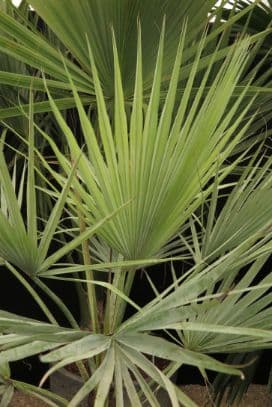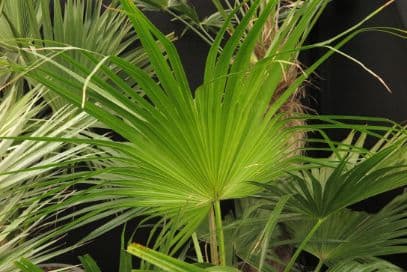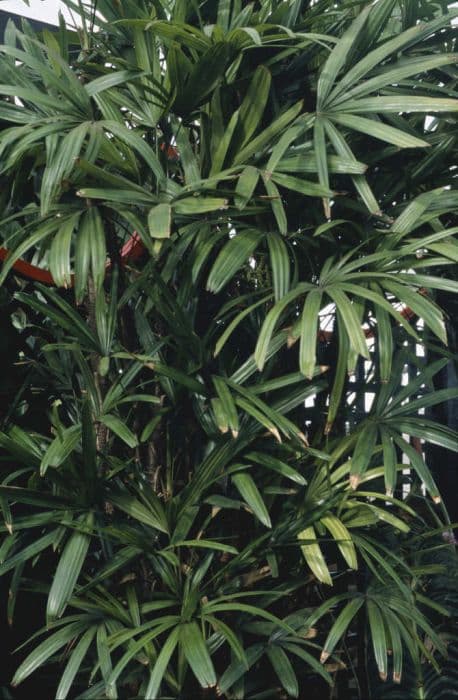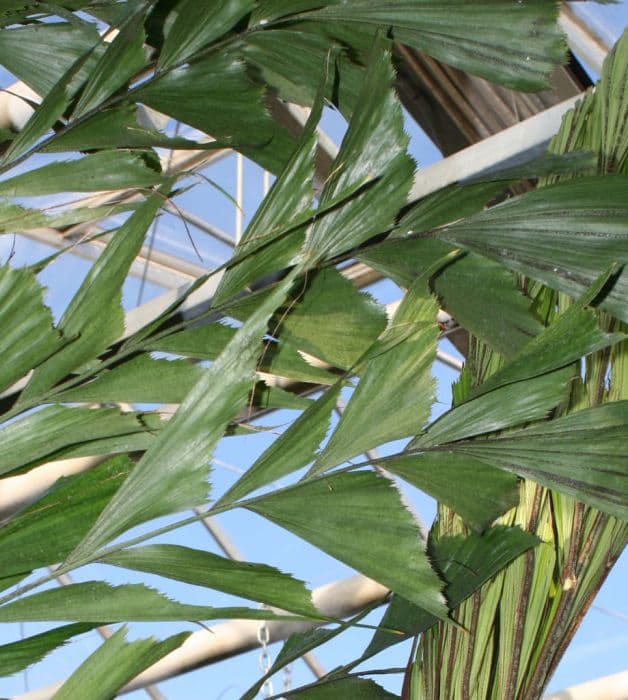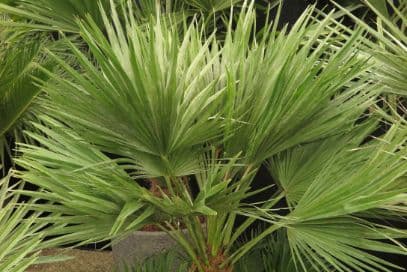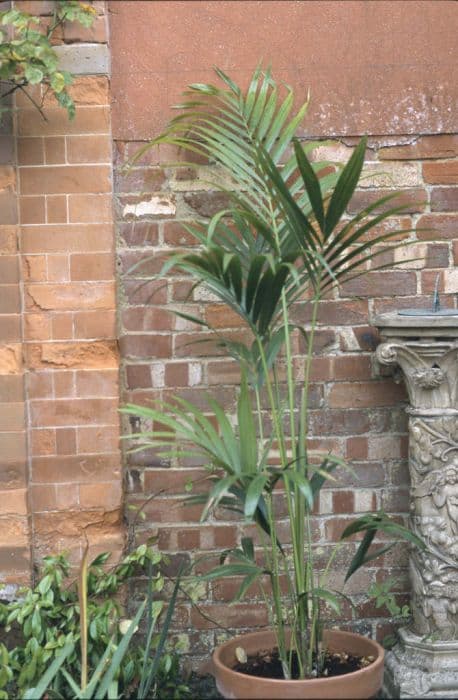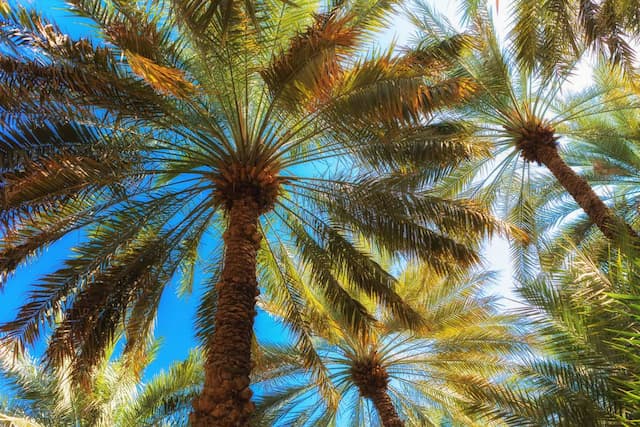Canary Island date palm Phoenix canariensis






ABOUT
P. canariensis is a tree-like palm to 15m or more, with a stout trunk and spreading deep green leaves to 5m in length, pinnately divided into many linear leaflets; drooping panicles of creamy-yellow flowers, followed by reddish-yellow fruits
About this plant
 Names
NamesSynonyms
Canary Island Date Palm, Canary Date Palm, Pineapple Palm, Canary Palm
Common names
Chamaerops canariensis, Phoenix cycadifolia, Phoenix excelsior, Phoenix macrocarpa
 Characteristics
CharacteristicsLife cycle
Perennials
Foliage type
Evergreen
Color of leaves
Green
Flower color
Yellow
Height
40 feet [12 meters]
Spread
20 feet [6 meters]
Plant type
Palm
Hardiness zones
9
Native area
Canary Islands
Benefits
 General Benefits
General Benefits- Ornamental Value: The Canary Island Date Palm is widely used in landscaping and garden design for its striking appearance and tall, impressive canopy.
- Shade Provider: With its large and dense fronds, it offers substantial shade, which can create cooler areas in gardens and public spaces.
- Climate Resilience: It is well-suited to withstand the conditions of Mediterranean and subtropical climates, being drought-tolerant once established.
- Habitat for Wildlife: The palm provides a habitat for various species of birds and insects, enriching local biodiversity.
- Erosion Control: The robust root system can help in stabilizing the soil, thus preventing erosion in the areas where it is planted.
- Symbolic Significance: In certain cultures, palm trees like the Canary Island Date Palm are symbols of victory, peace, and fertility.
- Economic Value: The Canary Island Date Palm is an important plant in the horticulture industry due to high demand for ornamental plants.
 Medical Properties
Medical PropertiesThis plant is not used for medical purposes.
 Air-purifying Qualities
Air-purifying QualitiesThis plant is not specifically known for air purifying qualities.
 Other Uses
Other Uses- Phoenix canariensis, commonly known as the Canary Island Date Palm, can be used to create a sweet syrup known as "palm honey". The sap is collected and reduced down to a thick syrupy consistency, often used as a natural sweetener.
- The dried leaves of the Canary Island Date Palm are traditionally used in making baskets, hats, and mats. This craft utilizes the natural strength and flexibility of the palm fronds.
- The trunk wood, being durable and robust, is sometimes employed in construction for making fences, furniture, or even as sturdy garden posts where weather resistance is desirable.
- The tree's fiber can be extracted and woven into ropes or cords, taking advantage of its natural resistance to decay and water.
- In some cultures, the Canary Island Date Palm's dry fronds may be soaked and twisted into doll or toy making, a testament to its flexibility and strength.
- The seeds of the Canary Island Date Palm can be processed and ground into a flour, which is sometimes used in making specialty breads or as a thickening agent.
- The bark of the palm is sometimes used as a natural scrubbing tool for cleaning or as a coarse fabric in rural applications.
- When the fronds are trimmed and properly dried, they can be turned into small decorative items or as part of the floral arrangements for unique textural accents.
- The large canopy of the Canary Island Date Palm provides natural shade in hot climates, creating an energy-free cooling solution for homes, outdoor seating areas, and public spaces.
- The dead fronds can be gathered and used as mulch, providing a nutrient-rich compost material for gardening and landscaping purposes.
Interesting Facts
 Feng Shui
Feng ShuiThe Canary Island Date Palm is not used in Feng Shui practice.
 Zodiac Sign Compitability
Zodiac Sign CompitabilityThe Canary Island Date Palm is not used in astrology practice.
 Plant Symbolism
Plant Symbolism- Resilience and Perseverance: The Canary Island Date Palm (Phoenix canariensis) is known for its ability to withstand harsh conditions and recover from damage, symbolizing the human qualities of resilience and perseverance.
- Victory and Success: Palms in general have been associated with victory and triumph since ancient times, and the Canary Island Date Palm, with its majestic appearance, can be seen as a symbol of success and accomplishment.
- Eternal Life: Due to its long lifespan, the Canary Island Date Palm may represent immortality and eternal life, aligning with the mythical phoenix's ability to be reborn from its ashes.
- Peace and Fertility: Palms have been symbols of peace and fertility; the Canary Island Date Palm, with its abundant fruit production, can be associated with prosperity and fecundity.
- Tropical Paradise: Because of its origin and lush appearance, the Canary Island Date Palm often symbolizes a tropical paradise, suggesting luxury, relaxation, and a sense of escape from the everyday.
 Water
WaterCanary Island Date Palms should be watered deeply to ensure the root zone gets sufficiently moistened. During hot summer months, watering once a week with about 15 to 20 gallons for a mature tree is recommended to maintain health and vigor, while young palms require around 2 to 5 gallons. In the cooler months, reduce watering to every two or three weeks, depending on rainfall and soil drainage. Consistent watering is important when the plant is establishing; however, they are drought-tolerant once established. Overwatering or poor drainage can lead to root rot, so allow the soil to dry out between waterings.
 Light
LightCanary Island Date Palms thrive in full sun environments but can tolerate partial shade. The best spot for planting is an area that receives direct sunlight for most of the day. Ensure the selected location is free from shade-causing obstacles to prevent the palm from growing towards light sources, potentially causing it to bend or lean.
 Temperature
TemperatureCanary Island Date Palms prefer warm conditions and are best suited to temperatures between 70 to 100 degrees Fahrenheit. Frost can damage the foliage, but they can survive brief cold dips down to 20 degrees Fahrenheit. For optimal growth, maintain a temperature above freezing, and note that prolonged exposure to cold below 25 degrees can be detrimental to the plant.
 Pruning
PruningCanary Island Date Palms require pruning to remove dead or dying fronds, as well as old fruit stalks, which can attract pests and look unsightly. Pruning is best done in spring or summer when the tree is actively growing. Prune only the fronds that hang below a horizontal line to prevent damaging the palm. This is typically an annual task to maintain aesthetics and plant health.
 Cleaning
CleaningAs needed
 Soil
SoilCanary Island Date Palms prefer a well-draining soil mix consisting of 2 parts peat or coco coir, 1 part pine bark, and 1 part coarse sand. The ideal soil pH for this palm is between 6.0 and 7.0.
 Repotting
RepottingCanary Island Date Palms are slow growers and should be repotted every 2 to 3 years when young, and less frequently as they mature.
 Humidity & Misting
Humidity & MistingCanary Island Date Palms tolerate a wide range of humidity conditions, but they thrive best in moderate to high humidity levels.
 Suitable locations
Suitable locationsIndoor
Ensure bright light, keep the soil dry between waterings.
Outdoor
Plant in full sun, well-draining soil, protect from cold.
Hardiness zone
9-11 USDA
 Life cycle
Life cycleCanary Island date palm (Phoenix canariensis) begins its life cycle as a seed, which, when planted in well-drained soil and given adequate warmth and moisture, will germinate and sprout a single shoot. The seedling gradually develops into a young palm with a rosette of pinnate leaves and a short stem that elongates over time. As it matures, the palm forms a thicker trunk with distinctive diamond-shaped leaf scars and a crown of arching fronds. Once it reaches sexual maturity, which can take several years, it produces inflorescences; the species is dioecious, so individual palms are either male or female. Female palms, if pollinated, will bear clusters of dates that, once mature, can be dispersed by animals or human intervention. The life span of a Canary Island date palm is quite long, often exceeding 100 years, during which it will continue to grow in height and girth while repeatedly producing flowers and fruits in seasons favorable for reproduction.
 Propogation
PropogationPropogation time
Spring to Summer
The most popular method of propagation for the Canary Island Date Palm (Phoenix canariensis) is by seeds. For successful germination, seeds should be sown in late winter or early spring when temperatures are consistently around 70°F (21°C). The seeds need to be soaked in warm water for 48 to 72 hours before planting to help break dormancy. They should then be planted in a well-drained seed starting mix, about one inch deep, and kept consistently moist but not overly wet. Germination can take several months, so patience is necessary. Once seedlings have developed several sets of true leaves and are large enough to handle, they can be transplanted into individual pots.
